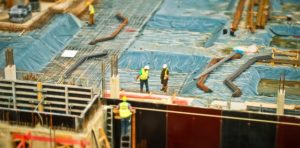Construction workers spend anywhere from 8 to 12 hours a day on their feet, or even longer, depending on what needs to get done and by what date and by what time. The average person doesn’t think about how active construction workers really are.
The construction industry itself is vast, meaning that there are many sectors one could train and become skilled for. But the one area I’m going to focus on is the guys and girls in the industrial general and form work division. These guys and girls are athletes in my eyes – they are the ones who are building the project with their bare hands.
Though some might not eat or even train like many athletes do, they still put their bodies through a daily grind that most people couldn’t imagine, and one that sometimes is not the healthiest either.
I can guarantee that you won’t find too many overweight form workers on a job site. They are up ladders, down ladders, picking up, or putting down on a constant cycle, until that 15-min break in the morning, followed by a half hour lunch, then another 15-min break in the afternoon … if you’re lucky.
I’ve always wanted to figure out how many km the average worker on a massive construction site walks in a single day. I’ve thought about trying a Fitbit to record how many steps are taken daily. It would also be interesting to see if there are any similarities between a pro athlete and a seasoned form worker…
Unfortunately, there’s not that much time for the average worker to rest his or her body enough for the next day of doing it all over again, and that takes a toll on the body.
Specially the legs – constant sore muscles on top of sore muscles. If you suffer from achy or tired leg muscle you might want to consider looking at trying out a pair of compression socks for the extra support.
Poor circulation can be the cause of achy legs. Compression socks, when worn throughout the day, will act to support the veins in your legs and improve the blood flow by squeezing the veins together to help bring the blood flow back to normal.
This helps them feel more rested at the end of the day. If you have varicose veins from bad circulation, compression socks will also help to manage and restore the proper blood flow throughout your legs.
Other occupations can also bring on achy, sometimes swollen, legs. For instance, factory workers, to restaurant employees, even the guy sitting on a plane going to Hawaii for a vacation.
Ultimately, anyone can be affected at any time. Someone with a medical condition might even be given a prescription for a certain calculated compression and style. And, with a prescription, your health insurance may even cover some or all of the cost, so check your insurance health benefit plan.
There’s many kinds of compression socks today to choose from, and all will offer something different, whether it’s height or thickness of the material or the compression itself on the leg. I personally have super-tight calf muscles and find that even wearing a taller sock just below the knee helps to relive some of the issues while on site.
And if you have a history of achy, tired legs it wouldn’t hurt to get the opinion of your doctor to see if they can make a recommendation for you before you make a purchase.
I would look for two pairs: one made for summer conditions and the other for colder weather conditions. The summer pair will be made from a lighter material so that your feet won’t sweat as much, and the winter/colder condition pair will be made out of a heavier material.
Don’t cheap out on the purchase, either. You’ll want a good quality pair that will last at least a season, if not longer. For construction workers, I recommend purchasing more then one pair once you find the ones that work for you. That way you don’t have to wash them everyday, and it will be more cost effective in the long run. And way more convenient.
Finding compression socks for construction workers shouldn’t be a challenge due to the many brands now offering ones suited for active outdoors people.
Look at compression socks that are made for running and outdoor sports. These will already be built with today’s lightweight materials and be geared for taking a beating.
The below-the-knee compression socks will also help in the winter months to add a little extra warmth to your day, plus they also work well with rubber boots.
If you have been in the construction industry long enough you’ll already know that old saying, “you get what you pay for”, and like your boots this also comes into play in a huge way.
You want them to stay in place and not stretch out over time from daily use, so it just makes sense to purchase ones that are made with the outdoors in mind. What you don’t want is your sock falling down all day long and having to constantly pull them up.
You might be thinking, “but these compression socks you recommend in the list below are all for those people that run in those races on the weekends for fun where you get mud on you and feel alive for 8 hours”.
My response to that is that you’re absolutely correct – however as construction workers you get to do this on a daily basis and have the bonus of getting paid for it as well. Never forget that you too are a highly skilled industrial athlete that does a job most people can’t or won’t do.
The list below is a great start to getting the comfort you need while on site. However finding the right pair that works best for you will make the difference out in the field.
Top five compression socks for construction workers
-
-
1) Mudgear: Men’s and women’s running socks built strong for outdoor sports performance and recovery.
Click here to see price 2) Physix Gear Sport: Compression socks for men and women, best graduated athletic fit for running, nurses, shin splints, travel and boosts stamina.
-

3) Acel: Designer compression socks graduated for performance and recovery

4) Alchemist: Rx compression socks for men and women
5) CSX: Compression socks for men and women.

